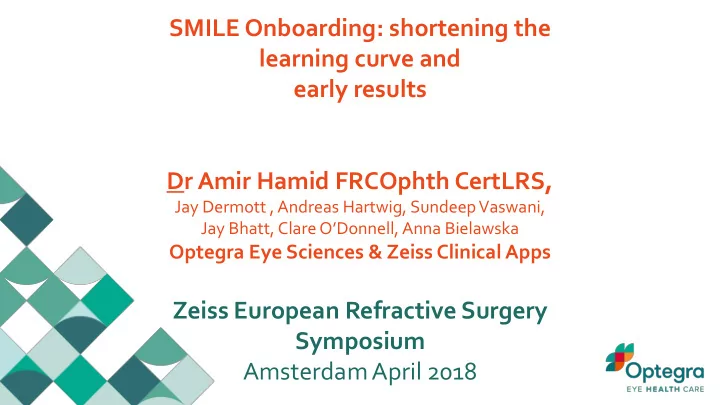

SMILE Onboarding: shortening the learning curve and early results Dr Amir Hamid FRCOphth CertLRS, Jay Dermott , Andreas Hartwig, Sundeep Vaswani, Jay Bhatt, Clare O’Donnell, Anna Bielawska Optegra Eye Sciences & Zeiss Clinical Apps Zeiss European Refractive Surgery Symposium Amsterdam April 2018
Challenges in Adopting SMILE • Challenging economic environment in Europe affecting Laser Vision Correction Market • LASIK is well established, safe and effective • Why learn a new technique? • Learning Curve • Patient Safety • Reputation 2 5/31/2018
The New SMILE On Boarding Process (clear, defined procedure) Each training step is a precondition for the following one and no step can be skipped!
Purpose of the study and methods Purpose: The purpose of this study was to demonstrate the safety and efficacy of an integrated training programme for adopting SMILE, A Control Group of Femto-LASIK patients was used as comparison Equipment : Zeiss Visumax Laser System (Carl Zeiss Meditec, Germany) Methods: Retrospective case series. The study population consisted of two groups of patients. All included eyes had CDVA of at least 6/6 prior to surgery Patients underwent one of either: SMILE surgery (242 eyes of 121 patients)or Femto-LASIK (445 eyes of 225 patients) The setting for the study was within a private eye hospital group in the UK. Unaided distance and near visual acuity (UDVA, DCNVA), spherical equivalent refraction and fluorescein enhanced tear break up time were evaluated pre- and post-operatively. Patient satisfaction data was gathered via an automated questionnaire. 4
Methods: Structured Training • Supervised by Zeiss Clinical Applications Team UK: Anna Bielawska • Theory based training with material provided by Zeiss • MCQs to assess learning • Attendance at London Vision Clinic SMILE Course: Prof Reinstein and Glenn Carp • Wet Lab training • Supervised surgical training in an approved Zeiss Training Facility • Certificate of Surgical Competency • Unsupervised surgery supported by Zeiss Clinical App Specialist • Visumax optimisation throughout 5
Results: Unaided Visual Acuity LASIK SMILE N 445 242 PreOp SE -3.89 ± 2.03 D -5.16 ± 2.25 D Monocular UDVA at least 6/12 444/445 (99.8%) 218/218 (100%) Monocular UDVA at least 6/6 393/445 (88.3%) 199/218 (91.3%) Binocular UDVA at least 6/6 199/211* (94.3%) 116/121 (95.9%) p>0.05 between groups for all parameters 24 monovision eyes excluded from monocular acuity analysis in SMILE group * Binocular acuity recorded for 211 of 225 patients 6
Predictabilty, Ocular Surface, Patient Satisfaction LASIK SMILE SE refraction within ±1 439/445 (98.7%) 214/218 (98.2%) SE refraction within ±0.50 391/445 (87.9%) 197/218 (90.4%) p>0.05 between groups for all parameters Fluorescein tear break up time was examined in a subgroup of the SMILE sample (N = 50) Mean TBUT Preop = 6.40 ± 1.83 seconds ± SD Mean TBUT Post-op = 5.76 ± 1.86 seconds ± SD Patient reported satisfaction with both procedures was high. 7
Waring Graphs Subgroup analysis 159 eyes with complete data at 1 month
High levels of UCDVA: Improves further at 3 months
At 3 months there is further improvement in vision: data to follow 52%
Highly predictable
Astigmatism correction is good
In conclusion… • The learning curve in adopting any new technique is well recognised in all surgical fields • The challenge is to ensure high quality results with minimal complications and high patient satisfaction • This study demonstrates that a structured training programme can produce excellent visual results within a safe an ethical environment for patients • We believe such a programme should be the template for adopting SMILE 14
Thank you very much for your kind attention 15
Recommend
More recommend